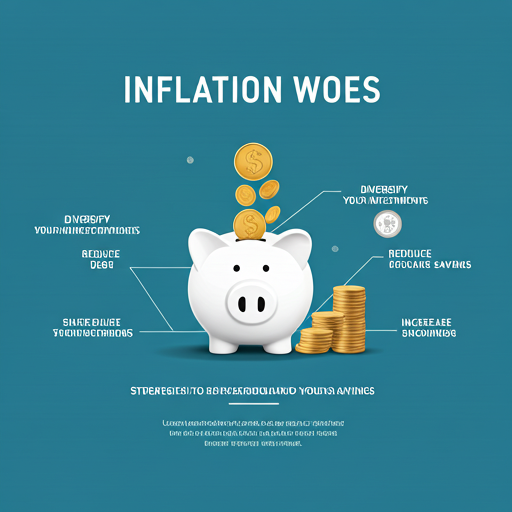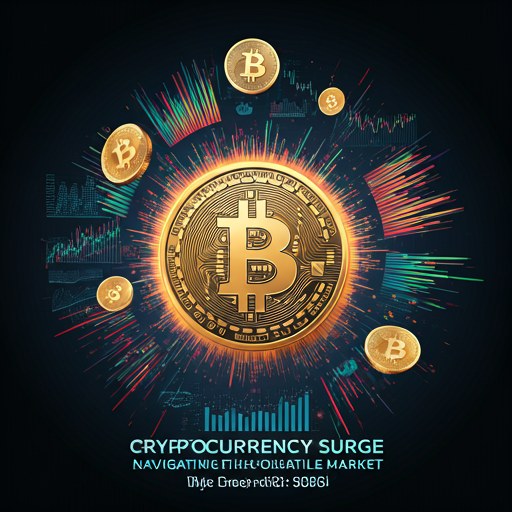Introduction to Cryptocurrency Surge
Understanding Cryptocurrency
Cryptocurrency represents a digital or virtual form of currency that utilizes cryptography for security. This technology ensures secure transactions and controls the creation of new units. The surge in cryptocurrency interest can be attributed to its decentralized nature, which appeals to investors seeking alternatives to traditional financial systems. Many are drawn to the potential for high returns. However, this market is characterized by significant volatility. Prices can fluctuate dramatically within short periods. Understanding these dynamics is crucial for informed investment decisions. Knowledge is power in this arena. Investors must stay updated on market trends and regulatory developments. Awareness can mitigate risks effectively.
The Rise of Digital Assets
The rise of digital assets has transformed the financial landscape. Investors are increasingly allocating capital to cryptocurrencies and blockchain-based tokens. Key factors driving this trend include:
These elements create a compelling case for digital assets. Many investors view them as a hedge against inflation. This perspective is gaining traction. The potential for high returns attracts both retail and institutional investors. Understanding the underlying technology is essential. Knowledge empowers better investment choices.
Market Dynamics and Trends
Market dynamics in cryptocurrency are influenced by various factors. Supply and demand play a crucial role in price fluctuations. Increased adoption leads to higher demand, which can drive prices up. This is evident in recent market trends. Regulatory developments also impact market sentiment significantly. Positive regulations can enhance investor confidence. Conversely, negative news can trigger sell-offs.
Key trends include the rise of decentralized finance (DeFi) and non-fungible tokens (NFTs). These innovations are reshaping traditional financial models. Investors must stay informed about these changes. Knowledge is essential for navigating this landscape. Understanding market dynamics is vital for success.
Importance of Market Awareness
Market awareness is crucial for any investor in cryptocurrency. He must understand the factors influencing price movements. This includes monitoring news, regulatory changes, and technological advancements. Staying informed helps him make timely decisions. Market sentiment can shift rapidly, impacting investment outcomes. Awareness of these dynamics can mitigate risks effectively.
He should also analyze historical trends to identify patterns. This analysis can provide insights into potential future movements. Knowledge empowers him to navigate volatility with confidence. Understanding market psychology is equally important. It can influence trading behavior significantly. Awareness is a key component of successful investing.
Factors Driving Market Volatility
Regulatory Changes
Regulatory changes significantly impact market volatility in cryptocurrency. For instance, new regulations can create uncertainty among investors. This uncertainty often leads to rapid price fluctuations. When governments announce stricter regulations, market reactions can be swift. Investors may panic and sell off assets quickly. This behavior can exacerbate price drops.
Conversely, positive regulatory news can boost market trust. When regulations are perceived as supportive, investment can increase. This influx of capital often stabilizes prices. Additionally, clarity in regulations can attract institutional investors. They typically seek a secure environment for their investments. Understanding these dynamics is essential for informed decision-making. Awareness of regulatory trends is crucial for success.
Technological Advancements
Technological advancements play a pivotal role in driving market volatility. Innovations such as blockchain scalability and smart contracts can alter market dynamics. These developments often lead to increased investor interest. When new technologies are introduced, they can create excitement. This excitement may result in rapid price increases.
However, technological failures or security breaches can have the opposite effect. Such incidents typically trigger panic selling among investors. Additionally, the emergence of competing technologies can disrupt existing markets. Investors must remain vigilant about these changes. Understanding technological trends is essential for strategic investment. Knowledge is key in this fast-paced environment.
Market Sentiment and Speculation
Market sentiment and speculation significantly influence cryptocurrency volatility. He must recognize that emotions often drive trading decisions. When optimism prevails, prices can surge rapidly. Conversely, fear can lead to sharp declines. This emotional response is often exacerbated by social media and news coverage. He should be aware of how these factors shape perceptions.
Speculative trading can amplify price movements, creating a feedback loop. As prices rise, more investors may enter the market. This influx can further inflate valuations. However, when sentiment shifts, the opposite occurs. Panic selling can lead to steep losses. Understanding market psychology is essential for effective investment strategies. Awareness of sentiment trends can enhance decision-making.
Global Economic Influences
Global economic influences play a critical role in driving market volatility. Economic indicators such as inflation rates and employment figures can significantly impact investor sentiment. For instance, rising inflation often leads to concerns about purchasing power. This concern can trigger sell-offs in various asset classes, including cryptocurrencies.
Additionally, geopolitical events can create uncertainty in the markets. When tensions arise, investors may seek safer assets, leading to price declines in riskier investments. Currency fluctuations also affect cryptocurrency valuations. A strong dollar can diminish the appeal of digital assets. Understanding these global economic factors is essential for informed investment decisions. Awareness can help mitigate potential risks.
Strategies for Navigating Volatility
Diversification of Portfolio
Diversification of a portfolio is a fundamental strategy for managing risk. By spreading investments across various asset classes, he can reduce exposure to any single investment’s volatility. This approach helps mitigate potential losses during market downturns. For example, combining cryptocurrencies with traditional assets can balance risk and reward.
Additionally, he should consider geographic diversification. Investing in international markets can provide further protection against local economic fluctuations. A well-diversified portfolio can enhance overall returns while minimizing risk. Understanding the correlation between different assets is crucial. Knowledge of these relationships can inform better investment choices. Diversification is a key component of a sound investment strategy.
Risk Management Techniques
Risk management techniques are essential for navigating market volatility. He should implement stop-loss orders to limit potential lozses. This strategy automatically sells an asset when it reaches a predetermined price . Additionally, position sizing is crucial in managing risk exposure. By allocating a specific percentage of his portfolio to each investment, he can control overall risk.
Furthermore, he should regularly review and adjust his portfolio. This practice ensures alignment with changing market conditions. Diversifying across asset classes can also reduce risk. It helps to mitigate the impact of poor performance in any single investment. Understanding these techniques is vital for long-term success. Knowledge is power in investment management.
Long-term vs Short-term Investment
Long-term and short-term investment strategies serve different purposes in a portfolio. He must recognize that long-term investments typically involve holding assets for several years. This approach allows for the compounding of returns and can mitigate short-term volatility. In contrast, short-term investments focus on quick gains, often requiring active management. He should be prepared for rapid market changes.
Additionally, long-term investors often benefit from market trends and economic growth. They can ride out fluctuations without panic selling. Short-term investors, however, may capitalize on market inefficiencies. This strategy requires constant monitoring and analysis. Understanding his investment goals is crucial for choosing the right approach. Knowledge of both strategies can enhance overall portfolio performance.
Utilizing Technical Analysis
Utilizing technical analysis is essential for navigating market volatility. This method involves analyzing price charts and patterns to forecast future movements. Key tools include:
By employing these tools, he can make informed trading decisions. Technical analysis helps him identify entry and exit points. It also allows for better risk management. Understanding market psychology is crucial in this context. Price movements often reflect collective investor behavior. Knowledge of technical analysis can enhance trading strategies.
Case Studies of Market Surges
Bitcoin’s Historic Price Movements
Bitcoin’s historic price movements illustrate significant market surges. For instance, in late 2017, Bitcoin experienced a meteoric rise, reaching nearly $20,000. This surge was driven by increased media attention and retail investor interest. Many viewed Bitcoin as a revolutionary asset. However, this rapid increase led to a sharp correction in early 2018. Prices plummeted, highlighting the volatility inherent in cryptocurrency markets.
Another notable surge occurred in late 2020, fueled by institutional adoption. Major companies began investing in Bitcoin, enhancing its legitimacy. This trend propelled Bitcoin to new all-time highs, surpassing $60,000 in early 2021. Understanding these price movements is crucial for investors. Awareness of historical trends can inform future investment strategies. Knowledge is essential inward navigating this volatile landscape.
Ethereum’s Growth and Challenges
Ethereum has experienced significant growth since its inception, driven by its unique smart contract functionality. This capability allows developers to create decentralized applications, attracting a vibrant ecosystem. In early 2021, Ethereum’s price surged past $1,400, fueled by the DeFi boom. Many investors recognized its potential beyond a mere cryptocurrency. However, Ethereum faces challenges, including scalability issues and high transaction fees. These factors can hinder its adoption and usability.
The fransition to Ethereum 2 .0 aims to address these concerns by implementing a proof-of-stake consensus mechanism. This upgrade is expected to enhance network efficiency and reduce costs. Understanding these dynamics is crucial for investors. Awareness of Ethereum’s growth and challenges can inform strategic decisions. Knowledge is key in this evolving market.
Emerging Altcoins and Their Impact
Emerging altcoins have significantly impacted the cryptocurrency market. Many of these coins offer unique features and solutions that differentiate them from Bitcoin and Ethereum. For instance, Cardano focuses on sustainability and scalability, attracting a dedicated following. In 2021, its price surged dramatically, reflecting growing investor interest.
Similarly, Solana gained attention for its high transaction speeds and low fees. This efficiency has positioned it as a strong competitor in the DeFi space. He should also consider the rise of meme coins like Dogecoin, which have captured public imagination. These coins can experience rapid price increases driven by social media trends. Understanding the potential of emerging altcoins is essential for informed investment decisions. Knowledge of their unique value propositions can enhance portfolio diversification.
Lessons Learned from Past Surges
Lessons learned from past surges provide valuable insights for investors. One key takeaway is the importance of not succumbing to FOMO, or fear of missing out. During the 2017 Bitcoin surge, many investors bought at peak prices, leading to significant losses. He should remain disciplined and avoid impulsive decisions.
Another lesson is the necessity of conducting thorough research. Understanding the fundamentals of an asset can help mitigate risks. For example, Ethereum’s rise was supported by its robust development community and use cases. Additionally, recognizing market cycles is crucial. Prices often correct after rapid increases, and he should be prepared for volatility.
Finally, diversifying investments can reduce overall risk. Spreading capital across various assets can protect against downturns. Knowledge of these lessons can enhance investment strategies. Awareness is essential for long-term success.
The Future of Cryptocurrency Markets
Predictions for Market Trends
Predictions for market trends suggest continued growth in the cryptocurrency sector. He may observe increasing institutional adoption as companies recognize the potency of digital assets. This trend could lead to greater market stability and legitimacy. Additionally, advancements in blockchain technology are likely to enhance scalability and security. These improvements can attract more users and investors.
Furthermore, regulatory clarity is expected to evolve, providing a more structured environment for cryptocurrencies. This development may reduce uncertainty and encourage participation. He should also consider the rise of decentralized finance (DeFi) platforms, which are reshaping traditional financial systems. The integration of cryptocurrencies into everyday transactions is becoming more feasible. Understanding these trends is essential for strategic investment decisions. Awareness of future developments can enhance his investment approach.
Potential Regulatory Developments
Potential regulatory developments are crucial for the future of cryptocurrency markets. He should anticipate increased scrutiny from governments worldwide. This scrutiny may lead to clearer guidelines for digital asset transactions. Such regulations can enhance investor protection and market integrity.
Moreover, he may see the introduction of taxation frameworks for cryptocurrency gains. This could create a more structured environment for investors. Additionally, regulations may focus on anti-money laundering (AML) and know your customer (KYC) requirements. These measures aim to prevent illicit activities in the crypto space. Understanding these potential changes is essential for informed decision-making. Awareness can help him navigate the evolving landscape.
Technological Innovations on the Horizon
Here are 10 trending article titles for a financial website based on the latest news and analysis of financial trends: No input data
Preparing for the Next Surge
Preparing for the next surge in cryptocurrency markets requires strategic planning. He should focus on diversifying his portfolio across various digital assets. This approach can mitigate risks associated with market volatility. Additionally, he must stay informed about emerging trends and technologies. Knowledge of market dynamics is essential for making informed decisions.
He should also establish clear investment goals and risk tolerance levels. This clarity will guide his investment choices during market fluctuations. Regularly reviewing and adjusting his portfolio is crucial. He can capitalize on opportunities as they arise. Understanding market sentiment can provide valuable insights. Awareness of potential surges can enhance his investment strategy.









